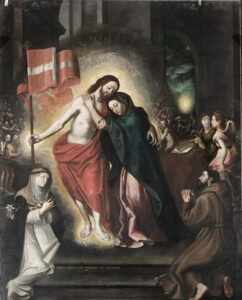By Monika Manser
Introduction
The most frequent way of praying that Saint Ignatius uses is that of imagining ourselves in a Gospel scene. We imagine ourselves as a character in the story. We take part in the story, seeing Jesus and all the other people, being aware of what’s going on and how we are feeling. The purpose of praying with the imagination is to allow Christ in the Scripture to speak to us. To bring the Gospel stories to life for us. We are not trying to recreate history. It doesn’t matter if your imagination takes the story off in a different direction to the Scripture. It doesn’t matter if the story takes place in 1st century Palestine or where we live now in the 21st century. What is important is what God wants to say to us through this passage.
Let us sit and relax so that together we can contemplate the Gospel using our imagination.
Prayer
We acknowledge we are in the presence of God so let us say together:
Direct O Lord and guide and influence all that is happening in my mind and heart during this time of prayer: all my moods and feelings, my memories and imaginings; my hopes and desires; may all be directed and influenced to your greater glory, praise and service and to my growth in your Spirit.
Amen
Let the Spirit guide our hearts and enlighten our minds to the mystery Jesus and his Resurrection
Reading
John 20:1-9
It was very early on the first day of the week and still dark, when Mary of Magdala came to the tomb. She saw that the stone had been moved away from the tomb and came running to Simon Peter and the other disciple, the one Jesus loved. ‘They have taken the Lord out of the tomb’ she said ‘and we don’t know where they have put him.’
So Peter set out with the other disciple to go to the tomb. They ran together, but the other disciple, running faster than Peter, reached the tomb first; he bent down and saw the linen cloths lying on the ground, but did not go in. Simon Peter who was following now came up, went right into the tomb, saw the linen cloths on the ground, and also the cloth that had been over his head; this was not with the linen cloths but rolled up in a place by itself. Then the other disciple who had reached the tomb first also went in; he saw and he believed. Till this moment they had failed to understand the teaching of scripture, that he must rise from the dead.
Contemplation
Today, Easter Sunday, we begin the fifty days of the Easter Season which ends with the Ascension of Jesus into Heaven. Today we celebrate the mystery of the resurrection of Jesus and contemplate on the discovery of the empty tomb by Mary of Magdala who assumes that Jesus body has been taken. ,Till this moment they had failed to understand the teaching of scripture, that he must rise from the dead,.
Where do you think Jesus went prior to him appearing to Mary of Magdala and the other disciples? Imagine a scenario that does not appear in the Gospels. Imagine that the first person to whom the risen Christ appeared was Mary, his Mother. Does this not seem a reasonable assumption given the central role she played in his life? Could this be the reason that the tomb was empty and there was a time delay between Jesus rising from the dead and him first being seen by Mary of Magdala and the disciples? I invite you to contemplate this meeting between Mother and Son and go to the place where Mary, the Mother of Jesus waits and imagine the scene unfolding before of you.
• Where is Mary waiting? Perhaps in John’s house since according to Scripture when ,Jesus saw His mother at the foot of the cross and the disciple whom He loved standing nearby, He said to her, “Woman, here is your son.” Then He said to the disciple, “Here is your mother.” So from that hour, this disciple took her into his home,.
• Can you imagine Mary sitting in the house overcome with the grief of watching her Son die a humiliating and excruciating death on the cross? Do you think she managed to sleep or was the horror of what she witnessed uppermost in her mind? Can you imagine her despair and heartache?
• Can you imagine Jesus coming to her? Was it still dark or was dawn starting to break through?
• Imagine the encounter, Mary full of joy at seeing her Son, Jesus full love for his mother. It would have been a very tender moment, Mother and Son in each others arms weeping and laughing. How do you think Jesus revealed his divinity to his Mother? Perhaps there was no need because Mary knew her Son.
• What do you imagine they said to each other? Perhaps Jesus would have had words of consolation for his Mother after her suffering of watching him die. Perhaps there were apologies from Jesus having put his Mother through so much pain. Perhaps there were apologies from Mary because she had felt so helpless during his Passion. Perhaps she felt she had not done enough to bring relief to his pain. Perhaps Jesus may have told his Mother how lonely, abandoned and betrayed he felt during his trial and crucifixion and that seeing her in in crowd gave him the courage he needed for enduring his suffering and death on the cross. Perhaps Mary told him of Simeon’s prophesy that a sword would pierce her heart and that she never realised what that meant until now.
• Can you imaging Jesus leaving his Mother saying that he now had to reveal himself to his disciples? Do you think that perhaps he asked her to look after them, console them, give them words of encouragement, help them believe until the time he would send his Advocate to them?
Speak to Mary about her encounter with her risen Son. Ask her to be your mother too, to help you become closer to her Son so that you too can be filled with the joy of the Resurrection.
Sharing
Let us now share what we thought, felt etc. only if you are comfortable to do so.
End Prayer
Suscipe of St. Ignatius of Loyola
Take, Lord, and receive all my liberty,
my memory, my understanding,
and my entire will,
All I have and call my own.
You have given all to me.
To you, Lord, I return it.
Everything is yours; do with it what you will.
Give me only your love and your grace,
that is enough for me.
Scripture texts: from the Jerusalem Bible 1966 by Dartington Longman & Todd Ltd and Doubleday and Company Ltd




